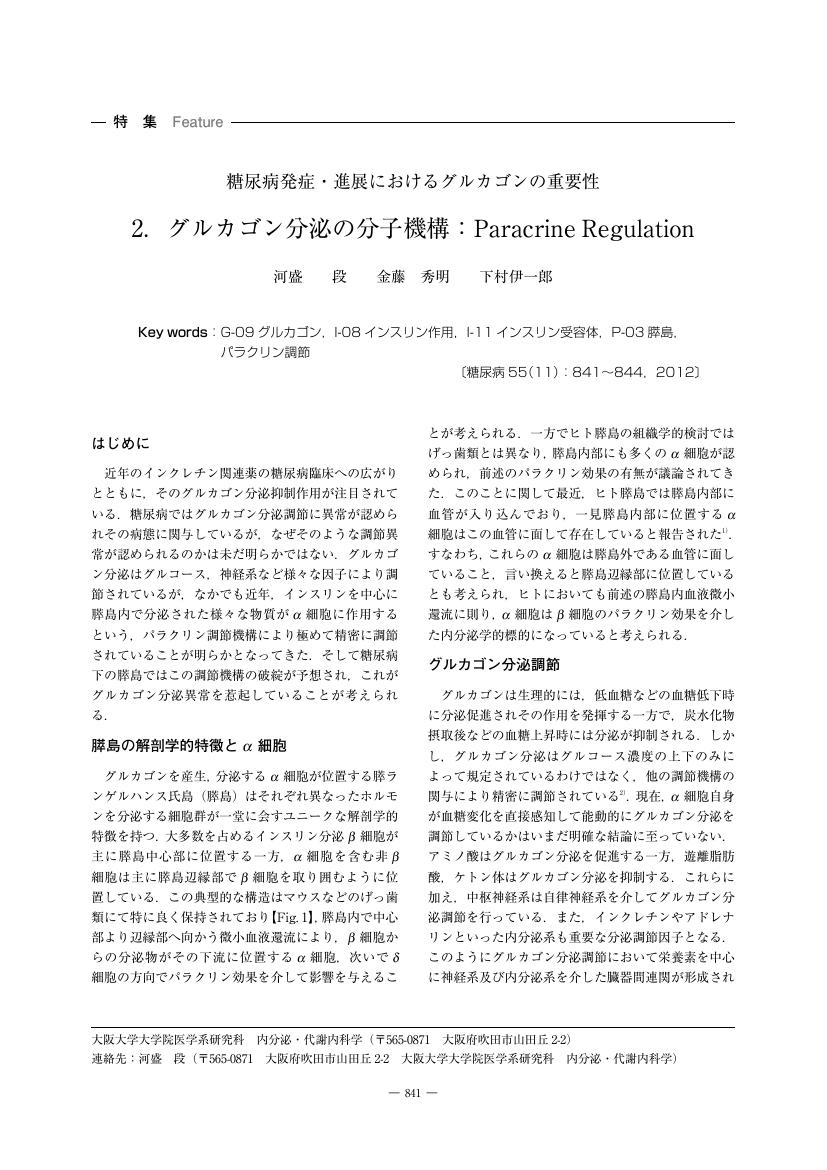14 0 0 0 OA 2.グルカゴン分泌の分子機構:Paracrine Regulation
- 著者
- 河盛 段 金藤 秀明 下村 伊一郎
- 出版者
- 一般社団法人 日本糖尿病学会
- 雑誌
- 糖尿病 (ISSN:0021437X)
- 巻号頁・発行日
- vol.55, no.11, pp.841-844, 2012 (Released:2012-12-12)
- 参考文献数
- 5
6 0 0 0 OA オピオイド長期投与中内分泌機能異常をきたした非がん性慢性痛症例
- 著者
- 植松 弘進 安田 哲行 田渕 優希子 真下 節 下村 伊一郎 柴田 政彦
- 出版者
- 一般社団法人 日本ペインクリニック学会
- 雑誌
- 日本ペインクリニック学会誌 (ISSN:13404903)
- 巻号頁・発行日
- vol.20, no.2, pp.102-106, 2013 (Released:2013-07-06)
- 参考文献数
- 13
- 被引用文献数
- 1
オピオイド長期投与中,内分泌機能低下症をきたした症例を経験した.症例は51歳男性で交通外傷による末梢神経障害を伴う左下肢複合性局所疼痛症候群の診断にて,受傷1年後より加療中であった.当初行われた投薬・神経ブロック等により痛みはコントロールでき,職場復帰していた.残存する痛みに対し受傷3年後より塩酸モルヒネによる内服加療を開始し痛みは軽減されたが,同時期より性欲低下の自覚症状が出現した.受傷7年後にはフェンタニル貼付剤へと変更し痛みのコントロールはさらに良好となったが,変更後数カ月で急激な体重減少(合計-24㎏)をきたし,変更後半年で強い全身倦怠感と食欲不振も出現し就労不可能となった.内分泌機能異常を疑い行ったホルモン負荷試験等の結果より,オピオイドによる続発性副腎機能低下症および中枢性性腺機能低下症と診断された.痛みのためにオピオイドを完全に中止できなかったため,トラマドール内服へと変更しホルモン補充療法を行った.ホルモン補充療法開始後は全身倦怠感等の自覚症状は改善した.このエピソードをきっかけに抑うつ状態となり職場復帰は果たせていないものの約9カ月で体重も回復した.
5 0 0 0 OA オピオイドによる内分泌機能異常
- 著者
- 田渕 優希子 安田 哲行 北村 哲宏 大月 道夫 金藤 秀明 井上 隆弥 中江 文 松田 陽一 植松 弘進 真下 節 下村 伊一郎 柴田 政彦
- 出版者
- 一般社団法人 日本ペインクリニック学会
- 雑誌
- 日本ペインクリニック学会誌 (ISSN:13404903)
- 巻号頁・発行日
- vol.20, no.1, pp.17-23, 2013 (Released:2013-03-22)
- 参考文献数
- 38
近年,非がん性慢性痛に対するオピオイド処方の選択肢が広がったことにより,オピオイドによる内分泌機能異常発症に留意する必要性がある.内分泌機能異常としては性腺機能低下症が最も多いが,副腎機能低下症や成人GH(成長ホルモン)分泌不全症の報告例も散見される.これらの内分泌機能異常は単に患者のQOLを低下させるのみならず,さまざまな代謝異常,臓器障害を呈し,時に生命の危機にかかわる病態へと進展することもある.現時点で,これらの内分泌機能異常がどのような患者に惹起されやすいかは明らかではなく,また内分泌異常の診断も必ずしも容易ではない.しかし,これらの内分泌機能異常はオピオイドの減量,中止,あるいは非オピオイド系鎮痛薬への変更,ホルモン補充療法により改善可能な病態であることから,オピオイド投与中の患者において決して見逃してはならない副作用の一つと考えられる.オピオイドによる内分泌機能異常について基礎医学的および臨床医学的見地から解説する.
2 0 0 0 OA 糖尿病性末梢神経障害による両下肢感覚異常に対する鍼治療の効果
- 著者
- 田口 敬太 石崎 直人 蘆原 恵子 伊藤 和憲 福田 文彦 下村 伊一郎 林 紀行 前田 和久 伊藤 壽記
- 出版者
- 一般社団法人 日本糖尿病学会
- 雑誌
- 糖尿病 (ISSN:0021437X)
- 巻号頁・発行日
- vol.60, no.7, pp.489-497, 2017-07-30 (Released:2017-07-30)
- 参考文献数
- 23
糖尿病性神経障害を有する患者に対する鍼治療の効果について検討した.治療は,1週間に1回の頻度で合計7回の鍼治療を行った.初回は置鍼のみとし,2診目からは低周波鍼通電治療を15分間行った.治療部位は下腿に位置する経穴,陽陵泉(GB 34)―太衝(LV 3),陰陵泉(SP 9)―太渓(KI 3)の計4箇所とし,左右に行った.1診目のしびれの平均VASは46.4 mm(95 %CI;36.7-56.1 mm),8診目のしびれの平均VASは24.7 mm(95 %CI;14.5-34.9 mm)であった.鍼治療前後でしびれの自覚症状に有意な改善が認められた(-22.0,95 %CI;10.6-33.5,p=0.001).また,2診目と8診目のこむら返りの回数についても鍼治療を行ったことでこむら返りの回数に有意な改善が認められた(Wilcoxonの符号順位和検定 p=0.045).以上のことから,鍼治療は副作用も少なく,一定の効果が期待できる為,糖尿病性神経障害を有する患者の治療法の一つとして有用な手段となりうることが示された.
1 0 0 0 OA 4.生体リズム障害と肥満症
- 著者
- 山岡 正弥 下村 伊一郎
- 出版者
- 一般社団法人 日本内科学会
- 雑誌
- 日本内科学会雑誌 (ISSN:00215384)
- 巻号頁・発行日
- vol.104, no.4, pp.710-716, 2015-04-10 (Released:2016-04-10)
- 参考文献数
- 10
ヒトを含む哺乳類では時計遺伝子により生体リズムが形成されている.それらの生体リズム障害を引き起こす代表例であるシフトワーカーでは肥満,代謝異常の発症リスクを増加させることが報告されている.またノックアウトマウスを用いた検討でも時計遺伝子異常と代謝異常の関連が報告されている.生体リズム障害とくに時計遺伝子異常がどのようなメカニズムで肥満症の病態に悪影響を及ぼしているのかは更なる調査が必要であるが,肥満,代謝異常合併者への対策には,生体リズムの改善といった観点からもアプローチが行われるべきである.
1 0 0 0 OA 肥満発症と動脈硬化
- 著者
- 下村 伊一郎
- 出版者
- 一般社団法人 日本動脈硬化学会
- 雑誌
- 動脈硬化 (ISSN:03862682)
- 巻号頁・発行日
- vol.23, no.7-8, pp.443-449, 1996-03-30 (Released:2011-09-21)
- 参考文献数
- 7
We clarified, using computed tomography, that the accumulation of intra-abdominal visceral fat is more closely associated with complications of obesity, such as diabetes mellitus, hyperlipidemia, hypertension and ischemic heart disease, than the accumulation of subcutaneous fat. Recently we also revealed that the accumulation of intra-abdominal visceral fat correlates to metabolic disorders and cardiovascular disease even in normal weight subjects. From these backgrounds, we proposed the concept of “visceral fat syndrome”, a multiple risk factors-clustering syndrome for the incidence of atherosclerosis. Clinically, it was showed that the reduction of visceral fat should be important for the cure and the protection of these disorders. We have suggested that physical exercise reduced accumulated visceral fat prominently from the observations of the effect of exercise therapy on visceral fat type obesity and the analysis of fat distribution of sumo wrestlers. In order to clarify the effect of exercise on fat distribution, the mRNA levels and the activities of acyl-CoA synthetase (ACS), lipoprotein lipase (LPL), and glucose transporter (Glut 4) in some tissues were compared between exercised and sedentary rats. We observed rapid decrease of tissue weight in visceral fat through marked decrease of ACS, LPL, and Glut 4 parameters, while there were no alterations of them in subcutaneous fat. Gastrocnemius muscle was heavier in exercised rats, and ACS activity elevated in the gastrocnemius muscle of the exercised rats. By analyzing the expressed genes in human visceral fat, compared with human subcutaneous fat and various tissues, visceral fat was showed to have a higher metabolic activity at fene expression level. We suggest that intra-abdominal visceral fat may contribute to switching of distribution of plasma energy flux, including lipid and glucose, from fat tissue to muscle in physical exercise, in rapid response to exercise from transcriptional level.
1 0 0 0 OA 劇症1型糖尿病の発症早期における膵臓MRI所見に関する調査報告
- 著者
- 徳永 あゆみ 今川 彰久 西尾 博 早田 敏 下村 伊一郎 阿比留 教生 粟田 卓也 池上 博司 内潟 安子 及川 洋一 大澤 春彦 梶尾 裕 川﨑 英二 川畑 由美子 小澤 純二 島田 朗 高橋 和眞 田中 昌一郎 中條 大輔 福井 智康 三浦 順之助 安田 和基 安田 尚史 小林 哲郎 花房 俊昭 日本人1型糖尿病の成因診断病態治療に関する調査研究委員会
- 出版者
- 一般社団法人 日本糖尿病学会
- 雑誌
- 糖尿病 (ISSN:0021437X)
- 巻号頁・発行日
- vol.61, no.12, pp.840-849, 2018-12-30 (Released:2018-12-30)
- 参考文献数
- 29
- 被引用文献数
- 2
劇症1型糖尿病は急激な発症と重症代謝異常が特徴である.本委員会では膵臓MRIのうち水分子の拡散制限を反映する拡散強調画像に注目し,劇症1型糖尿病発症早期における診断への有用性を検討した.画像データが存在する劇症1型糖尿病症例14例について,拡散の定量化指標であるADC(Apparent Diffusion Coefficient)値を算出し,非糖尿病対照例21例と比較した.劇症1型糖尿病症例では膵臓の全領域でADC値が有意に低下し,膵全体にわたる単核球浸潤による細胞密度上昇が示唆された.ADC値の最良のカットオフ値を用いると,診断感度86 %,特異度71 %であり,非典型例2例の診断にも有用であった.また,劇症1型糖尿病症例におけるADC値は血糖値および動脈血pHと有意に相関し,発症後経過とともに上昇傾向であった.以上より,膵臓MRI拡散強調画像は劇症1型糖尿病の効率的な診断の一助となることが示唆された.
1 0 0 0 OA リラグルチドが関与して生じた麻痺性イレウスの2例
- 著者
- 北村 哲宏 大月 道夫 久保 典代 倉敷 有紀子 玉田 大介 田淵 優希子 小澤 純二 安田 哲行 沖田 考平 今川 彰久 金藤 秀明 船橋 徹 下村 伊一郎
- 出版者
- 一般社団法人 日本糖尿病学会
- 雑誌
- 糖尿病 (ISSN:0021437X)
- 巻号頁・発行日
- vol.55, no.12, pp.982-986, 2012 (Released:2013-01-21)
- 参考文献数
- 8
Glucagon-like peptide-1(GLP-1)受容体作動薬であるリラグルチドの副作用として食欲不振,嘔気が報告されている.今回我々は,リラグルチドが関与した麻痺性イレウスの症例を2例経験した.ともに腹部手術歴はなく,リラグルチド導入時に前兆なく嘔吐にて突然発症した.症例2はインフルエンザを併発していた.2例ともにリラグルチド中止にてイレウスの改善を認めた.背景として,便秘の既往,15年以上の罹病期間,糖尿病末梢神経障害および自律神経障害を有している点が共通していた.これまでリラグルチドによるイレウスの報告はなく,今後GLP-1受容体作動薬を使用する際には副作用としてイレウスを念頭に置く必要があり報告する.
1 0 0 0 OA 1.肥満の役割
- 著者
- 下村 伊一郎 船橋 徹 松澤 佑次
- 出版者
- 一般社団法人 日本内科学会
- 雑誌
- 日本内科学会雑誌 (ISSN:00215384)
- 巻号頁・発行日
- vol.93, no.4, pp.655-661, 2004-04-10 (Released:2008-06-12)
- 参考文献数
- 6
- 被引用文献数
- 6 3
肥満・脂肪蓄積が糖尿病,高脂血症,高血圧といった動脈硬化につながる疾患群の基盤病態であることが明らかとなり,診断・治療の両面より,肥満状態の評価・対応が重要となる.近年の研究により,これまで単なるエネルギーの貯蔵倉庫と考えられてきた脂肪組織が実はさまざまな生理活性分泌因子群(アディポサイトカイン)を内分泌し,生体の代謝・動脈壁の恒常性の維持に重要な役割をはたすこと,その産生バランスの異常が上記疾患群を引き起こすこと,崩れたバランスを正常化させることが疾患の治療につながることが示された.アディポネクチン,レプチン, PAI-1, TNF-αといったアディポサイトカイン制御は,今後metabolic syndrome治療の中心になってくる可能性が高い.
